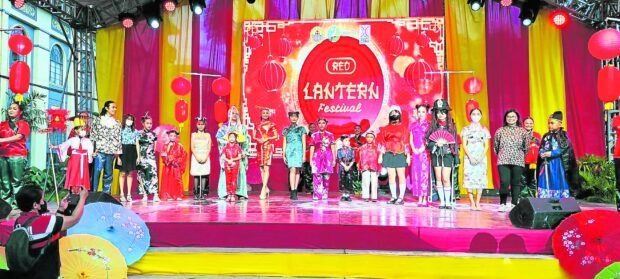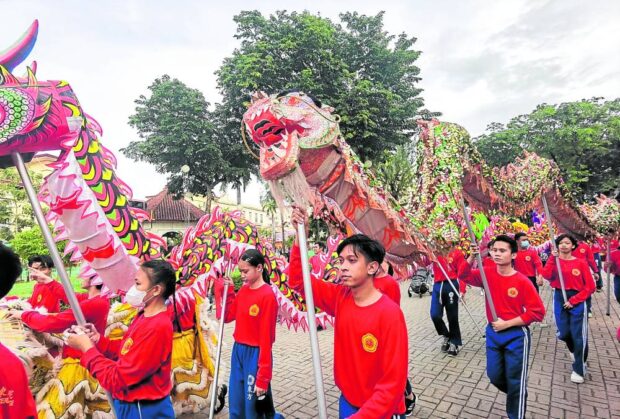Visayas’ deep-rooted Chinese ties help push regions’ growth

Performers from the Filipino-Chinese community were presented during the first-ever Red Lantern Festival in Cebu City on Jan. 21, 2023, the eve of the Chinese New Year. CEBU CITY NEWS AND INFORMATION
Even before the Spaniards ruled the Philippines for 333 years, the Visayas was already a bustling trade route for Chinese merchants.
But like other places in the country, the contributions of Chinese traders to the region go beyond the products sold in the streets or on display in shopping malls.
Filipinos of Chinese descent have created a strong and active community in the Visayas whose influence extends from entrepreneurship to nation-building through sociocivic activities.
In Iloilo province, the Chinese-Filipino community is among the key contributors to the economy and local cultural heritage, Ilonggo historian Randy Madrid told the Inquirer.
In terms of economic and urban development, Madrid said the “Chinese and Chinese-Filipino capital became the backbone of the urban economy.”
“The boom of the textile industry ushered in the formation of the first urban concentration that served as the foundation of Iloilo’s urbanization,” he said.
According to Madrid, the textile industry is one of the lasting Chinese and Chinese-Filipino cultural emblems that remain with the Ilonggos.
Chinese mestizos, he said, eventually got involved in the development of the sugar industry, as well as the preservation of the all-too-popular pancit Molo and the batchoy “that can be Chinese-inspired but have found meaning and relevance to Ilonggo taste.”
Early communities
Madrid said the Chinese began to establish a community in Ogtong, presently Oton town, as early as the 14th century.
When the Spaniards came and the colonial capital was transferred to the Arevalo District in 1581, he said the Chinese businessmen were primarily engaged in local trading. Later, they also went into the business of forging cannons and ammunition, making sails for galleons, and bells for churches.
“With the founding of the pariancillo of Molo in 1780, they were active in the exportation of local weaves and importation of foreign textiles, making Iloilo the ‘Textile Capital of the Philippines’ by the mid-19th century,” Madrid said.
A “parian” or “pariancillo” is a trading center and quarter designated by the Spanish government where the Chinese population is concentrated. Madrid confirmed that in the past, the Chinese population was concentrated in Molo. He surmised that the “good number of Chinese mestizos in Molo attests it’s a former Chinese quarter.”
At present, there are around 12,000 to 13,000 Chinese-Filipinos living in and around Iloilo. Many of them are still into commercial ventures, specifically engaged in the “buy and sell” business.
These traders, Madrid said, are highly concentrated in the Downtown Central Business District, on Aldeguer, Iznart and J.M. Basa Streets.
The Chinese Friendship Arch, an iconic symbol of Chinese presence in Iloilo, was constructed by the Filipino-Chinese Chamber of Commerce of Iloilo on Iznart Street in the downtown area in 2012 to honor the close ties between the Chinese-Ilonggo community and the local government.
While the area has markers commonly associated with the typical “Chinatown,” Madrid believed it is erroneous to call it as such because “it’s totally different from the Binondo experience.”
“It is better to call it ‘Chinese enclave,’” he said.
At present, the Molo District is popularly known as Iloilo’s Chinatown as the Chinese influence is palpable in many institutions and landmarks around this metropolis.
Among them are the Iloilo Chinese Temple on Rizal Street, and the Iloilo Chinese Commercial High School, now known as Hua Siong College of Iloilo, on Aldeguer Street.
Established as a preparatory school by the Filipino-Chinese Chamber of Commerce of Iloilo in 1912, it is the first Chinese school outside of Metro Manila and the second-oldest in the country.
Cooperation, support
Cebu City, considered as the Queen City of the South, does not have any particular Chinatown.
In 2018, Councilor Jerry Guardo filed a proposed ordinance in the city council to transform the downtown area into a Chinatown center to boost the economic growth of the city.
The proposed ordinance, however, did not prosper, especially after then Cebu City Mayor Tomas Osmeña issued a statement about the city not having a Chinatown.
According to Osmeña, a foreign journalist once asked him why there is no Chinatown in Cebu when all the major cities of the world have one.
His response: “Cebu has no Chinatown because Cebu is Chinatown. We are also Muslimtown, Koreatown, Eurotown, and everything else.”
Osmeña said the Chinese are always welcome in Cebu, which they chose as their home, as the city is the center of trade and commerce in the Visayas.
Guardo said he would consult the council’s committee on tourism of the city council to talk about his idea, especially that Cebu City has no official Chinatown until now.
“I want to reintroduce my plans of having a Chinatown in the city. I think it’s about time to have one,” Guardo told the Inquirer.
He added: “The Chinese community has been very cooperative and supportive. They do have a lot of contributions to our society, especially in our economy and tourism.”
Downtown Cebu used to be the lone center of business and shopping activities in the city before other areas, such as the North Reclamation Area and South Road Properties, were developed in the 1990s.
Colon Street, the Philippines’ oldest road, also lies in the heart of downtown Cebu City, and connects the historic village of Pari-an, where many Chinese traders used to live, to the Carbon Public Market, the biggest in the city.
However, in recent times, the city’s downtown area has been plagued by deteriorating infrastructure with old buildings, road diggings and broken drainage systems turning many people away.
Peaceful existence
In Bacolod City, the 888 Chinatown Mall on Gatuslao Street remains to be the go-to place for those who want to have a feel of China, not because the vendors there are Chinese but because most products offered there are imported from China.
From DVDs, vintage clothing, appliances, and toys to popular food chains, they all have it. The mall is in its full spirit during the Christmas season and the Chinese New Year.

Students from a Chinese school in Cebu City prepare to perform the traditional Lion Dance during the first-ever Red Lantern Festival in Cebu City on Jan. 21, 2023, the eve of the Chinese New Year. CARBON PUBLIC MARKET FACEBOOK PAGE
In Eastern Visayas, there also has been a thriving presence of Filipino-Chinese businessmen, especially in the town of Alangalang in Leyte province.
According to Verwena Bibar, planning and municipal development officer of the town, these traders help generate jobs for locals, as well as support the town by way of the taxes they pay.
Recently, two big Chinese-owned establishments opened in the town of over 57,000 people.
Jimmy Yaokasin Jr., one of the prominent families of Chinese descent in Eastern Visayas, said the presence of the Filipino-Chinese community had contributed to the growth of local communities.
“With the businesses they established, they hire a lot of people, pay taxes, contribute to charitable institutions, do community service like volunteer fire brigades, build schools, conduct medical missions, (and) disaster relief operations,” he said.
Read Next
Subscribe to INQUIRER PLUS to get access to The Philippine Daily Inquirer & other 70+ titles, share up to 5 gadgets, listen to the news, download as early as 4am & share articles on social media. Call 896 6000.
For all the latest Business News Click Here
For the latest news and updates, follow us on Google News.



